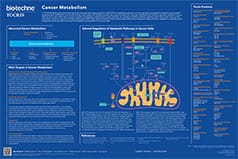NAMPT
Nicotinamide phosphoribosyltransferase (NAMPT), EC 2.4.2.12, is an enzyme that catalyzes the transfer of a phosphoribosyl group from 5-phosphoribosyl-1-pyrophosphate (PRPP) to nicotinamide, forming nicotinamide mononucleotide (NMN) a key NAD pathway intermediate.
NAMPT Inhibitors |
|
|---|---|
| Cat. No. | Product Name / Activity |
| 6753 | CHS 828 |
| NAMPT inhibitor; active in vivo and cytotoxic | |
| 8072 | FK 866 |
| Potent and non-competitive NAMPT inhibitor; induces apoptosis and autophagy | |
| 4484 | STF 31 |
| NAMPT inhibitor; also GLUT1 inhibitor | |
NAMPT Activators |
|
| Cat. No. | Product Name / Activity |
| 4076 | P7C3 |
| NAMPT activator; also proneurogenic and neuroprotective | |
Degraders |
|
| Cat. No. | Product Name / Activity |
| 7842 | NAMPT PROTAC® A7 |
| Potent and selective nicotinamide phosphoribosyl transferase (NAMPT) Degrader (PROTAC®) | |
Nicotinamide phosphoribosyltransferase (NAMPT), EC 2.4.2.12, is an enzyme that catalyzes the transfer of a phosphoribosyl group to nicotinamide (NAM), forming nicotinamide mononucleotide (NMN), which is then converted to nicotinamide adenine dinucleotide (NAD). The formation of NMN is the rate limiting step for the synthesis of NAD, an important intermediate of cell metabolism and redox reactions. Next NAD-dependent enzymes, such as poly (ADP-ribose) polymerase (PARP) and sirtuins, catalyze NAD to produce NAM (the predominant NAD precursor in mammals), which is then recycled by NAMPT, completing the cycle.
NAMPT exists in two forms, intracellular (iNAMPT) and extracellular (eNAMPT). iNAMPT is found in the nucleus, cytoplasm and mitochondria, whereas eNAMPT is found in the extracellular space. The role of iNAMPT is clearly defined as a NAD biosynthetic enzyme. It regulates NAD levels and recycles NAM, which in turn modulates cell metabolism, oxidative stress and inflammation. However the role of eNAMPT (previously known as visfatin and pre-B-cell colony-enhancing factor 1) has not yet been fully defined; current theories include a role as a proinflammatory cytokine, insulin mimetic and NAD biosynthetic enzyme.
Overexpression of NAMPT plays a key role in cancer metabolism because of its modulatory effects on glucose and lipid metabolism, oxidative stress and inflammation. Increased levels of iNAMPT in some cancers, have been linked to angiogenesis through aberrant activation of ERK1/2 pathways, and induction of vascular endothelial growth factor (VEGF) and matrix metalloprotease (MMP) secretion. NAMPT levels are also increased in inflammatory diseases such as Crohn's disease, with eNAMPT possibly acting as a proinflammatory cytokine. Abnormal NAMPT activity has also been linked to diabetes by influencing insulin resistance.
External sources of pharmacological information for NAMPT :
Literature for NAMPT
Tocris offers the following scientific literature for NAMPT to showcase our products. We invite you to request* your copy today!
*Please note that Tocris will only send literature to established scientific business / institute addresses.
Cancer Metabolism Poster
This poster summarizes the main metabolic pathways in cancer cells and highlights potential targets for cancer therapeutics. Genetic changes and epigenetic modifications in cancer cells alter the regulation of cellular metabolic pathways providing potential cancer therapeutic targets.
